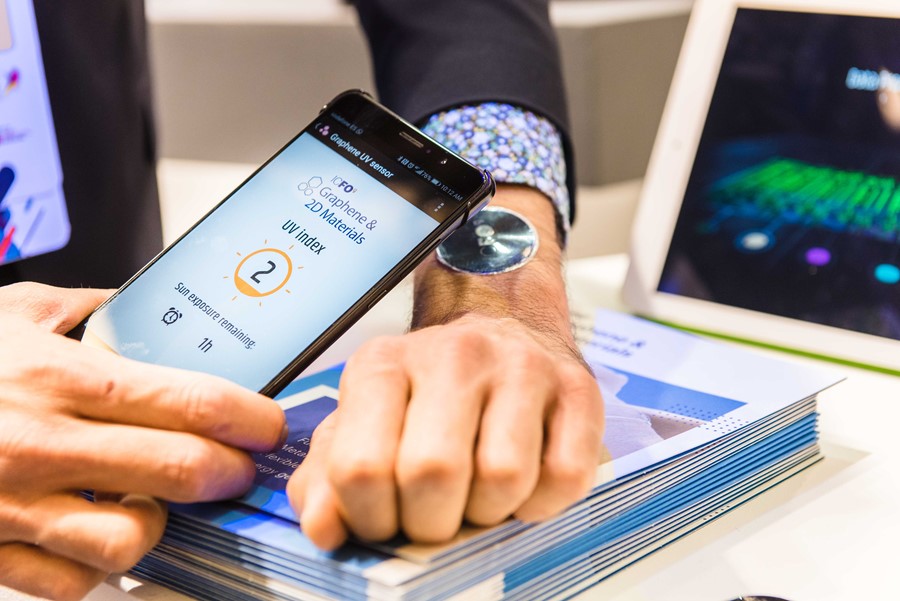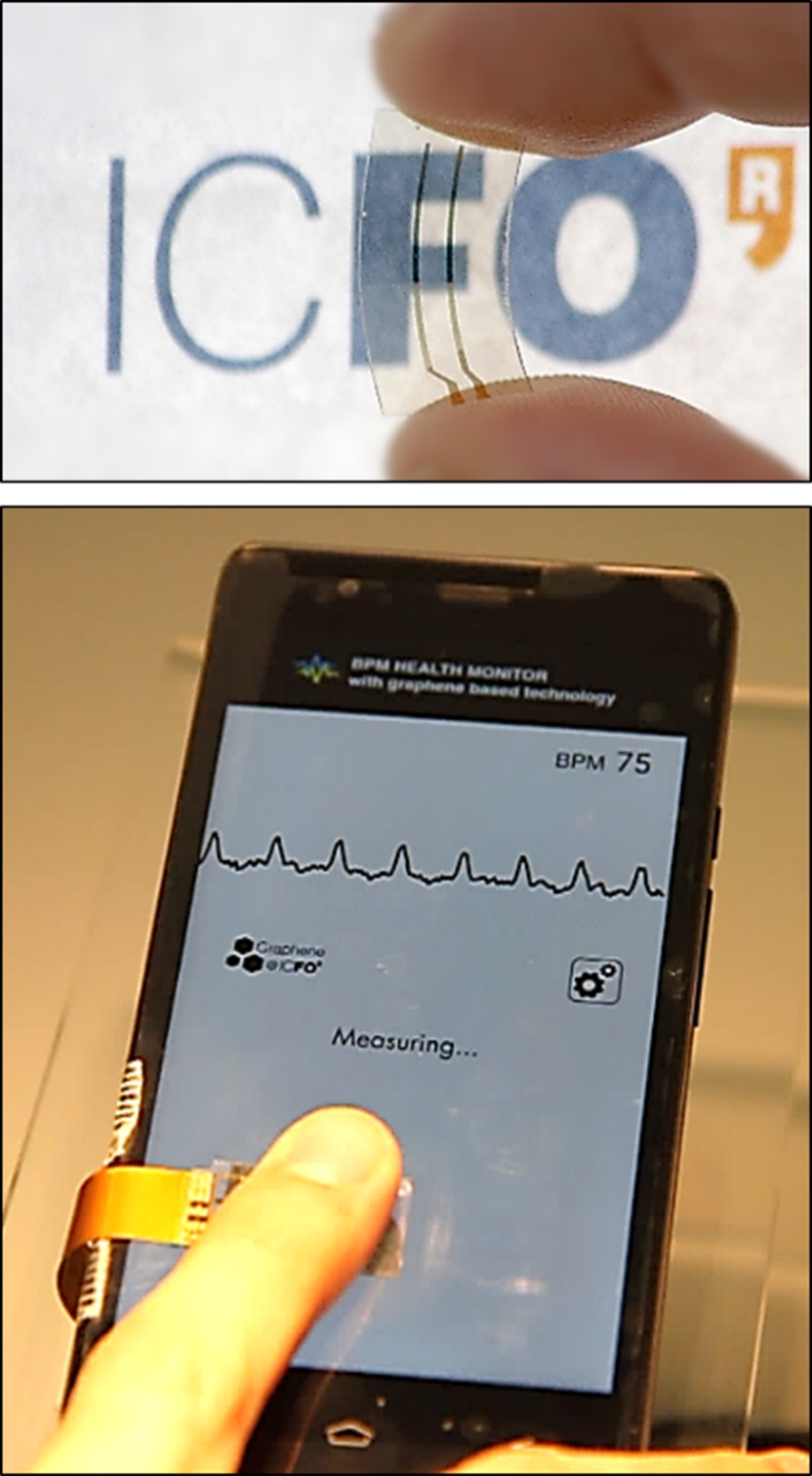Graphene enables flexible and transparent health monitors
A new class of flexible and transparent wearable devices conforms to the skin, providing continuous and accurate measurements of multiple human vital signs – heart rate, respiration rate, blood pulse oxygenation, and exposure to UV radiation.
New technological devices enable non-invasive tracking of vital signs beyond fitness monitoring. Wearable technologies also help prevent common health problems such as heart failure, hypertension, and stress related complications, among others. Optical detection mechanisms provide an approach to report on our bodies' inner workings, and they have strongly penetrated the consumer market. Current wearable technologies, based on hard components, do not deliver the desired accuracy and can only monitor a limited number of vital signs. To tackle this problem, Graphene Flagship researchers at ICFO, Barcelona, have created flexible non-invasive optical-based sensors that can measure a broader set of vital signs.
In a study published in Science Advances, the Graphene Flagship researchers reported a new class of flexible and transparent wearable devices conformable to the skin, providing continuous and accurate measurements of multiple human vital signs. These devices can measure heart rate, respiration rate and blood pulse oxygenation, as well as exposure to UV radiation from the sun. While the device measures the different parameters, the read-out is visualized and stored on a mobile phone interface connected to the wearable via Bluetooth. In addition, the device can operate battery-free, since it is charged wirelessly through the phone.
Emre Ozan Polat from Graphene Flagship partner ICFO stated that "it is very important to demonstrate the wide range of potential applications for our advanced light sensing technology through the creation of various prototypes, including a flexible and transparent bracelet, a health patch integrated on a mobile phone and a UV monitoring patch for sun exposure. All of them are versatile and efficient due to these unique features."
The bracelet adapts to the skin surface and provides continuous measurement during activity. It also incorporates a flexible light sensor that can optically record the change in volume of blood vessels, due to the cardiac cycle, and then extract different vital signs such as heart rate, respiration rate and blood pulse oxygenation.
Moreover, researchers integrated a graphene health patch onto a mobile phone screen, which instantly measures and displays vital signs in real time when a user places their finger on the screen. A unique feature of this prototype is that the device uses ambient light to operate, promoting low-power-consumption and allowing continuous monitoring of health markers over long periods of time.
This advanced light sensing technology incorporates two materials: graphene, a highly flexible, transparent, one-atom thick layer of carbon atoms; and light-absorbing quantum dots. This technology brings a new form factor and design freedom to the wearable field, making graphene quantum dot-based devices a strong platform for product developers.
The Graphene Flagship researchers demonstrated that their sensor provides a broad wavelength detection range, extending the functionality beyond the visible range. Using the same core technology, they fabricated a flexible UV patch prototype capable of wirelessly transferring both power and data, which operates battery-free to sense the environmental UV-index. The patch operates with low power consumption and has a highly efficient UV detection system that can be attached to clothing or skin, and used for monitoring radiation intake from the sun, alerting the wearer of any possible over-exposure.
Frank Koppens, Graphene Flagship Work Package Leader for Photonics and Optoelectronics, and author of the Science Advances paper, says: "We are excited about the prospects for this technology, pointing to a scalable route for the integration of graphene quantum dots into fully flexible wearable circuits to enhance form, feel, durability, and performance. These results show that this flexible wearable platform is compatible with scalable fabrication processes, proving that mass-production of low-cost devices is within reach in the near future."
Antonios Oikonomou, the Graphene Flagship Business Developer for Flexible and Wearable technologies, based at ICFO in Barcelona, emphasises that "the booming wearables industry is eagerly looking to increase the fidelity and functionality of its offerings. Our graphene-based technology platform answers this challenge with a unique proposition: a scalable, low-power system capable of measuring multiple parameters while allowing the translation of new form factors into products."
Maria Smolander, the Graphene Flagship Work Package Leader for Flexible Electronics, added that "this combination of graphene quantum dot-based detectors integrated into flexible bracelets and skin patches enables the exploitation of these graphene-based optical sensors for several wearable applications, from alerting UV exposure to monitoring of vital signs. Scalability of the fabrication process based on hybrid integration, wireless powering of the device and the possibility to integrate the functionalities into flexible, even stretchable devices are key benefits in this promising development."
Andrea C. Ferrari, Science and Technology Officer of the Graphene Flagship and Chair of its Management Panel, adds: "This is an excellent example of the Flagship's combined efforts in (opto)electronics and flexible devices. The Graphene Flagship identified these two areas as key for future developments in its science and technology roadmap. These devices, with new functionalities, not feasible with standard state of the art technologies, validate our vision, and bring graphene and related materials ever-closer to the consumer electronics market."
Reference
'Flexible graphene photodetectors for wearable fitness monitoring.' Polat et al., Sci. Adv. 2019; 5: eaaw7846.

ICFO's flexible and transparent wearable devices can connect to a mobile phone app to display heart rate, respiration rate, blood oxygen levels and UV exposure. (Credit: ICFO)

The graphene smart medical patch connects to a mobile phone to read multiple vital signs instantly from the finger. (Credit: ICFO)



